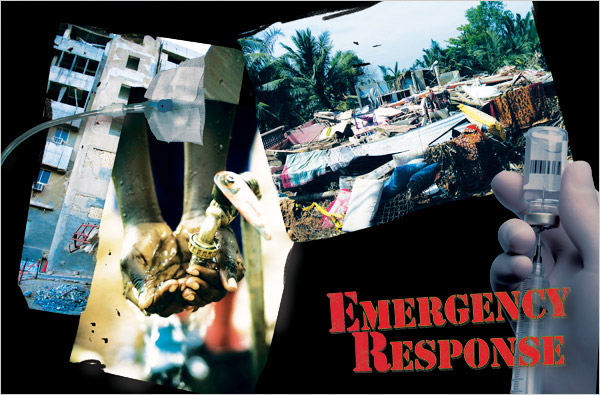Feature: Emergency Response
 Crisis engineers bring needed skills and order to disaster zones, easing victims’ plight with water, shelter, and sanitation systems — from the September 2009 issue of Prism magazine, by Thomas K. Grose.
Crisis engineers bring needed skills and order to disaster zones, easing victims’ plight with water, shelter, and sanitation systems — from the September 2009 issue of Prism magazine, by Thomas K. Grose.LONDON — Soon after a devastating cyclone struck the Southeast Asian country of Myanmar (Burma) in early May 2008, killing around 150,000 people, British civil engineer Paul Jawor packed his bags and grabbed his passport. Taking a month-long leave from his job as a highway engineer in southeast England, Jawor hired on as a water sanitation specialist with Médecins Sans Frontières — also known as Doctors Without Borders — and headed to Myanmar’s Irrawaddy Delta, one of the worst-hit areas. There he quickly devised ways to give 25,000 disaster victims life-saving potable water and helped organize deliveries of rice.
Jawor, 44, was a good choice for the job. He’s an experienced humanitarian engineer who, since 1999, has been regularly parachuting into crises. And MSF knew his credentials were impeccable, as Jawor is a member of the international disaster relief organization RedR. For nearly 30 years, London-based RedR has been recruiting and giving expert training to those engineers and other professionals willing to rush to work in disaster zones, both natural and manmade. Since 1980, 2,500 RedR members have been dispatched to nearly every major humanitarian crisis that’s erupted around the world, from famines to earthquakes to floods to war. It’s not duty for the faint of heart. Jawor’s own roster of hot spots includes Zimbabwe, Afghanistan, Iraq, Sri Lanka, Kashmir, and Angola. As he notes, “People tend to not go on holidays to the places I’ve worked.”
Read the entire article in Prism online
Introduce students to an eGFI lesson on tsunami structure survival
Filed under: Special Features








